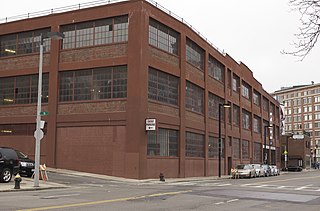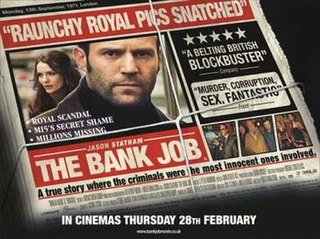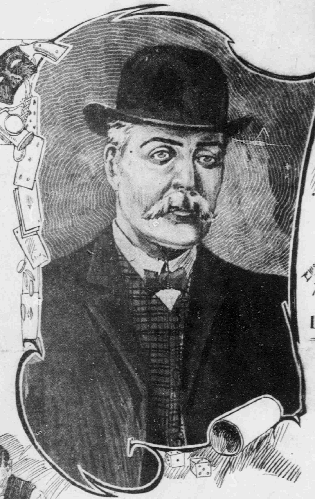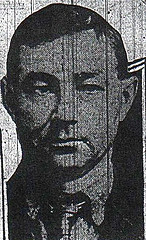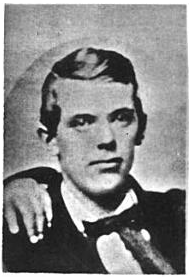Planning
Those were involved were Leslie, Dunlap, Robert Scott, "Billy" Connors, Billy Porter, Gilbert Yost, James Burns, Johnny Irving, "Red" Leary, and Thomas "Shang" Draper, [3] [4] though the ones who ultimately robbed the bank were Dunlap, Scott, Connors, Irving, Porter, Draper, and Yost. [14] Out of the group, Leslie was the only one not known to New York police and the Pinkerton detective agency as a criminal. [15]
Initially, Dunlap and Scott had asked Mandelbaum about their plan to rob the Northampton bank. Mandelbaum let the two contact Leslie, who agreed to mastermind the robbery for a fee of $20,000. [11] Connors was eventually involved. Leslie had never worked with Dunlap, Scott, or Connors before. Leslie was not involved with the burglary physically, though he planned every part of it; it was Scott who had asked Leslie for his expertise. [8] They chose a code name for their group, which was the "Rufus Gang", [14] or Rufus Ring, [3] named after Robert Scott. [16] Northampton National Bank was chosen because it had vaults and safes that were easy to open, [4] and various sources claimed the vaults contained large cash reserves. [17] They found out about the bank through Edson, who recommended the bank in exchange for a share of the stolen money. [4] [18] The amount agreed to was $50,000. [16]
Edson visited Dunlap and Scott at the Wyoming Valley Hotel in Wilkes-Barre, Pennsylvania, on August 5, 1875. Dunlap sent Edson (here named W.L. Edwards) a telegram to invite him:
WILKESBARRE, Pa., Aug 5, 1875. To W.L. Edwards, 241 West Fifty-second street, New York.
Come to-morrow.
R.C. HILL.
Handwriting on that telegram and one other belonged to Dunlap. At the hotel, in the hotel registry, the names "R.C. Hill" from Boston, and "Wm. D. Edson" were written. Dunlap wrote the signature for "R.C. Hill" and Edson wrote his name. [19]
Starting in September, [20] the group, including Leslie, [11] travelled between Brooklyn and Northampton, to plan and watch the bank employees and deputy sheriff. They planned how they would escape, and where they would hide the money. [3] They knew that the bank's night watchman leaves at 4 a.m. Leslie planned for the money to be hid in the Bridge Street Cemetery, which was just off the main thoroughfare of Northampton, and was close to the train station, which would be used as the getaway, and Bridge Street School; at some point, a base of operations was set up in the school's attic. It was decided to not use the roof to get inside the bank, as the third floor of the bank was the private residence of Judge Thomas Forbes. [11] The gang decided to find a bank employee who might offer his involvement for a cut of the resulting money, so they spent several days observing Whittlesey. [21] They found out "everything about him, his family, and their routines." [17] His house was about two-thirds of a mile from the bank. [22] They decided he could not be bribed, and found another way to use Whittlesey to their advantage. [17] They found Whittlesey left work at 4 p.m., and then the night watchman, Deputy Sheriff Henry Potter stayed overnight. [23] After learning this, Edson became involved. [17]
On November 22, Edson went to the bank to found out what he could about the vault and the safe combination. [17] Edson told the bank manager, Thomas Warriner, that he was on there on Herring & Co. business, and that he had to examine the vault as part of "routine maintenance" on the safe. [5] [17] Warriner said the vault keys were a little "tight", and Edson said he could fix that. Warriner allowed Edson to remove the locks, and take them along with the vault key and the bank key. [17] [24] He took them back to his private boarding house in town where he worked on them. He made wax impressions of the keys, which he then gave to Dunlap and Scott. Edson went back to the bank, returned the keys, and suggested that a new vault combination should be made, but only one person, John Whittlesey, should know it. Warriner agreed, and Edson left. A new combination was made, that both Whittlesey and Warriner knew about. [3] [5] [17] The last thing investigated were the hours of Henry Potter. They found Potter left at 4 a.m. and Whittesey opened at 8 a.m., leaving 4 hours in which the bank was unattended. [23] Leslie approved the final plan. [14]
After several months, Leslie eventually turned his plans over to Dunlap, Scott, and Connors. The three then secured the involvement of Leary, Porter, Draper, Irving and Yost, who had been recommended by Leslie. Leslie had chosen them for their experience and indebtedness to Fredericka "Marm" Mandelbaum, Leslie's mentor, which made them less likely to betray the group. Another reason was that Leslie had been having an affair with Shang's wife Babe, and Red's wife Kate. Shang and Red being in Massachusetts meant there was more time for Leslie to be with the women in New York. [9]
At some point, the gang tried twice to rob the bank, but failed. [5]
A few weeks prior, the gang met at a livery yard, and they told someone there that they had planned to do a surprise party in Holyoke. A hostler was able to get a clear look at one of the robbers, who was unnamed. [25] On the morning of January 25, 1876, Dunlap and Scott were witnessed in Springfield, Massachusetts, by Albert Holt, paymaster of the Boston and Albany railroad company. Dunlap and Scott met three other men at two different points. Holt also saw Scott and Dunlap enter a store in Springfield on the 26th. [12]



